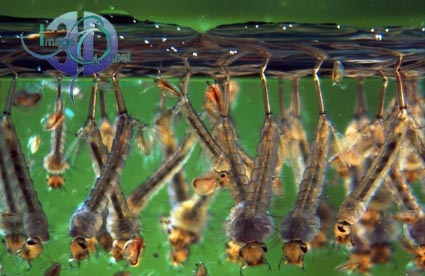|
Mosquito Larvae ©
2000 by Image Quest 3-D
Read our copyright notice
Culex Mosquitoes are "true flies" and belong to the Culcidae family. These are nearly all blood-sucking insects and they are responsible for the spread of several serious diseases, including malaria, yellow fever and elephantiasis. Mosquitos are slender, long-legged flies in which the veins and the hind margins of the wings are covered with scales. A slender proboscis projects from the head in both sexes, although only the females use it for sucking blood. Males can be recognised by their bushy antennae, whose delicate hairs are sensitive to the flight tones of the females and thus enable the males to home in on mates. Mosquito larvae live in water, although many species are very particular about the kind of water in which they live. The eggs are usually laid on the water surface and those of some species, such as Culex and Culiseta, are glued together to form tiny rafts. The larva has a well-developed head and a very broad thoracic region. It is well supplied with hairs and moves through the water with a jerky motion. It feeds on protozoans and other minute plankton, which it wafts into its mouth with tufts of hairs. Mosquitoes fall into two distinct groups - the anophelines and the culicines. This photograph illustrates culicine larvae that hang at an angle from the freshwater surface, whereas anopheline larvae rest horizontally just below the surface water film. This difference in orientation is due to the positions of the spiracles - on a respiratory horn in the culicines and on the dorsal body surface in the anophelines.
Click here to view the 'Picture of the Week' archive.
|
||||||||
|
|
||||||||


